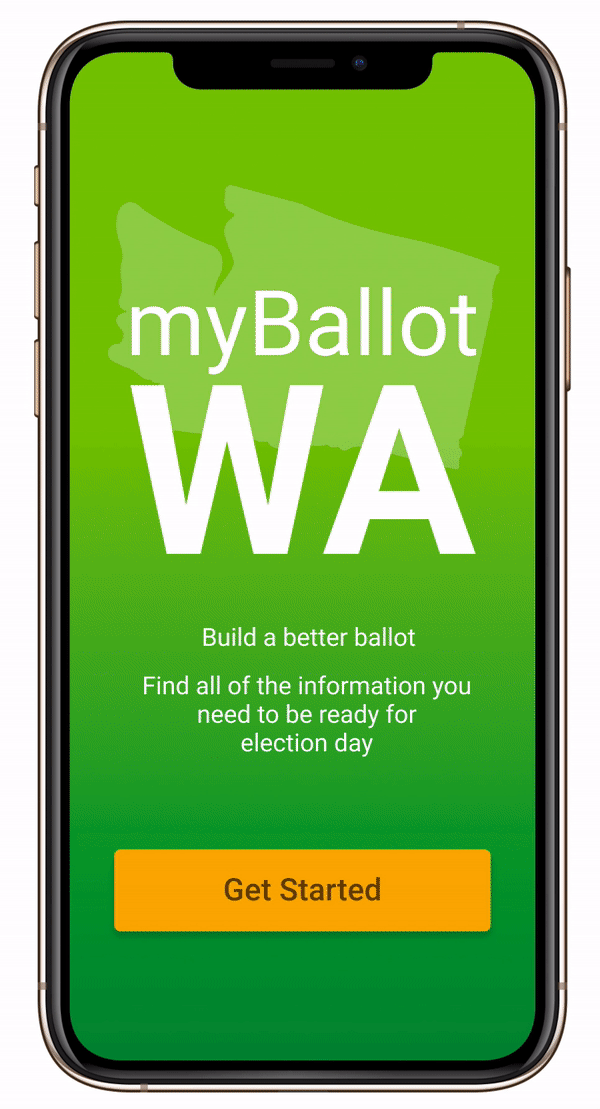myBallot WA
General Assembly hackathon 2020 winner
Our Hackathon team, Ctrl+Alt+Elite team, designed, developed, and deployed a responsive mobile application, myBallot WA, to serve as a voter reference tool. myBallot WA was imagined as an accompanying application to the Washington mail-in ballots and an environmentally conscious replacement of the paper Voters’ Pamphlet mailed to each registered voter.
Scope and constraints
Three-day hackathon sprint
Lead UX Researcher of Ctrl+Alt+Elite
Figma
Sketch
Roles and responsibilities
Tools used
Voter Background research
-
In 2016, statistics on illiteracy showed that 43% of American adults read at a basic or below basic reading level.
-
There are currently no collective sites or platforms with candidate information which leads to inconsistencies in information.
-
In 2016, a Reuters poll showed that 32.5% of Democrats and 35% of Republicans state they are unfamiliar with their own party’s congressional candidates.
-
There is currently no nationwide voting format
-
Some states vary between counties
-
Voters do not understand the ballot language: Ballot instructions and language describing referendums are often written at an inaccessible reading level.
Voters do not know the candidates: Many voters are unsure which candidates are up for election, particularly in local elections, until they receive their ballot votes.
Assumptions
Based on the challenges we discovered, our team also formed basic assumptions for an average user.
1. Voters want to feel prepared to vote
2. Voters want background on the candidates
3. Voters have a basic reading level
4. Voters speak, read, and write in English
Hypothesis
Voters will feel more prepared to vote if they have an easy-to-read sample ballot in an intuitive format that allows them to decide on all candidates and issues before election day.
Challenges
methods used
-
Heuristic
-
Research Plan
-
Complete interviews
-
Design studios
-
Problem statement and how might we
-
Low fidelity prototyping
-
High Fidelity prototyping
-
Presentation
-
Research report and plan
Voting in Washington
Since 1983, Washington state has offered the ability for residents to vote via mail-in ballots for every individual registered to vote. The current Washington voting system has many unique nuances specific to the state.
Residents are mailed a paper ballot 18 days before the election. Finished ballots may be mailed back via the attached pre-paid postage or dropped off at designated community boxes.
In addition, a General Election Voters’ Pamphlet with details about candidates, referendums, and proposed initiatives are mailed to every household in Washington and available in various languages upon request.
So, what is the problem?
-
Despite having a mail-in system, not all voters receive their paper pamphlet due to a mismatch in address due to relocation, outdated voter registration, or other unspecified issues.
-
The voters’ pamphlet creates a considerable paper waste
-
Skepticism about shifting to technological solutions to replace the current mail-in ballot system.
Starting the process

-
Users were unsure of the intended functionality of the application
-
Numerical indication of available fields by each category to inform users of form expectations
-
Personalized ballot based on geolocation, automatically populating available candidates in their district
-
Collapsable sections to empower users to scan or learn more, if desired

-
Ballot measures explained in simplified language.
-
Candidates’ top 3 campaign priorities listed to provide a quick overview of core voting issues.
-
Print, share, email functions to allow users to use completed ballots as a reference tool.
-
Users were uncertain why and to whom they were meant to be sharing or emailing their ballots.
-
final redesign

-
The ‘Share’ call-to-action was eliminated to remove confusion about why and to whom users were meant to be sharing or emailing their ballots.
-
An accessible color palette was applied to create an inclusive and aesthetically pleasing design for all users.
-
Topic headings and overall copy text were simplified to improve the accessibility of the reading level.
-
Fixed scrolling was implemented to better orient users and constantly display categories when viewing positions and measures.
Reflections
a great start with room for improvement
As a whole, our current setup of the site was met with great reviews. Users seem very engaged with learning more about not only the candidates but the function of each office. While the site is a great step in the right direction, there is still more to be done.
An unstated assumption of the myBallot | WA design is that users speak English. Due to the time constraints of this sprint, the team could only focus on a design for English speakers. However, to improve inclusivity, accessibility, and voter engagement, additional languages should be implemented in the future.
To improve accessibility and inclusivity for all voters, video candidate profiles would make a unique feature in the future.
what i enjoyed about this project
This Hackathon provided me insights into what working with a product development team may entail; collaborating with different departments, learning the pain points my co-workers may face, and moving past them together to create a fantastic product. I quickly learned how to communicate my design ideas with developers and researchers while learning about their approach and process.